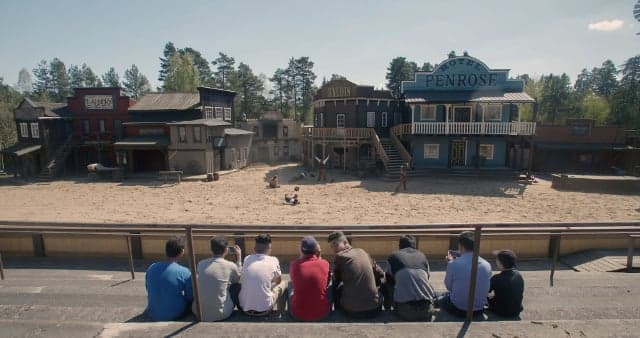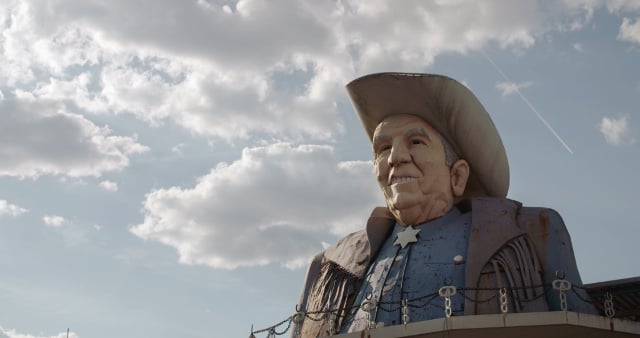Video: How a Wild West theme park became a home for refugees in Sweden

The American producers of a documentary on a Wild West amusement park in Sweden that provided housing for 500 Syrian refugees have explained to The Local why they felt the need to return to the park and finish telling its story.
MEL Films released the "High Chaparral" documentary about the theme park of the same name in 2016, looking at how the already unusual Wild West style theme park in Sweden became unlikely housing for 500 refugees in the winter of 2015, as Sweden's Migration Agency struggled for rooms during the peak of the refugee crisis.
They weren't content, and recently decided to revisit the park in the sequel "Return to High Chaparral". But how did documentary makers from Los Angeles find out about an amusement park in rural Sweden in the first place?
"I had no idea there was an American-style Wild West theme park in Sweden. I didn't know how well that piece of American mythology exported. That could be its own story," director David Freid told The Local.
READ ALSO: How Sweden handled the refugee crisis
As a small startup competing in the world of big media outlets in LA, the filmmakers have to turn over every stone in order to sniff out intriguing angles. While they knew they wanted to touch on the Syrian refugee crisis for example, they weren't sure how to approach it, until they saw a couple of lines about High Chaparral online, sparking the idea.
When they flew to Sweden, what they found there was a community atmosphere, where people were busy learning Swedish, trying to grasp the intricate Swedish immigration system, and were "generally active and engaged" compared to refugees they met in different surroundings. "High Chaparral was an incredibly unique scenario that would be difficult to replicate," the director noted.
"It turned out to be a beautiful story of contrasts, and for the first High Chaparral – of hope. But the political winds have shifted a lot in a year".
Return to High Chaparral from MEL Films on Vimeo.
Which is why they felt the need to go back. Since 2015, good will towards refugees has given way to backlash, with populist forces in particular making capital out of tensions. When MEL Films returned to the park for their second film, that shift was noticeable.
"There was definitely a change of attitude. The tone of the news coverage was different. There seemed to be less optimism at the park due in large to our timing. We were there on the last day the majority of the refugees had before they had to move on," Freid explained.
The residents, on the other hand, seemed grateful for the opportunity they had been given. Though getting a true sense of what they thought was difficult with a camera in the room and a language barrier, the filmmakers admitted:
"Everyone we spoke with remained grateful to have any opportunity at all. They want to contribute and to give back, but it's never easy to get an authentic sense of things when you've got big cameras in a room. Small honest moments were happening in Arabic that we didn't realize until we had the footage translated. A sense of frustration with the situation".
"It's not easy to stick a camera in a family's face and say 'just act normal' when there's nothing at all normal about their situation," he added.

High Chaparral is definitely unique. Photo: MEL Films
In the time since the first film was made, Sweden's stance on refugees has also become big news in the US, where no less than the country's president, Donald Trump, has painted it as a disaster. But that view isn't representative of all Americans, Freid stressed.
"In one version of America, I think Sweden is seen as some failed communist state where immigrant crime is out of control. In another version of America, there's still a belief in the Wild West values of the American settlers – that a person has a right to start a new life away from hardship and persecution. And they generally think Sweden has its shit together," he concluded.
READ ALSO: How is Sweden tackling its integration challenge?
Comments
See Also
MEL Films released the "High Chaparral" documentary about the theme park of the same name in 2016, looking at how the already unusual Wild West style theme park in Sweden became unlikely housing for 500 refugees in the winter of 2015, as Sweden's Migration Agency struggled for rooms during the peak of the refugee crisis.
They weren't content, and recently decided to revisit the park in the sequel "Return to High Chaparral". But how did documentary makers from Los Angeles find out about an amusement park in rural Sweden in the first place?
"I had no idea there was an American-style Wild West theme park in Sweden. I didn't know how well that piece of American mythology exported. That could be its own story," director David Freid told The Local.
READ ALSO: How Sweden handled the refugee crisis
As a small startup competing in the world of big media outlets in LA, the filmmakers have to turn over every stone in order to sniff out intriguing angles. While they knew they wanted to touch on the Syrian refugee crisis for example, they weren't sure how to approach it, until they saw a couple of lines about High Chaparral online, sparking the idea.
When they flew to Sweden, what they found there was a community atmosphere, where people were busy learning Swedish, trying to grasp the intricate Swedish immigration system, and were "generally active and engaged" compared to refugees they met in different surroundings. "High Chaparral was an incredibly unique scenario that would be difficult to replicate," the director noted.
"It turned out to be a beautiful story of contrasts, and for the first High Chaparral – of hope. But the political winds have shifted a lot in a year".
Return to High Chaparral from MEL Films on Vimeo.
Which is why they felt the need to go back. Since 2015, good will towards refugees has given way to backlash, with populist forces in particular making capital out of tensions. When MEL Films returned to the park for their second film, that shift was noticeable.
"There was definitely a change of attitude. The tone of the news coverage was different. There seemed to be less optimism at the park due in large to our timing. We were there on the last day the majority of the refugees had before they had to move on," Freid explained.
The residents, on the other hand, seemed grateful for the opportunity they had been given. Though getting a true sense of what they thought was difficult with a camera in the room and a language barrier, the filmmakers admitted:
"Everyone we spoke with remained grateful to have any opportunity at all. They want to contribute and to give back, but it's never easy to get an authentic sense of things when you've got big cameras in a room. Small honest moments were happening in Arabic that we didn't realize until we had the footage translated. A sense of frustration with the situation".
"It's not easy to stick a camera in a family's face and say 'just act normal' when there's nothing at all normal about their situation," he added.

High Chaparral is definitely unique. Photo: MEL Films
In the time since the first film was made, Sweden's stance on refugees has also become big news in the US, where no less than the country's president, Donald Trump, has painted it as a disaster. But that view isn't representative of all Americans, Freid stressed.
"In one version of America, I think Sweden is seen as some failed communist state where immigrant crime is out of control. In another version of America, there's still a belief in the Wild West values of the American settlers – that a person has a right to start a new life away from hardship and persecution. And they generally think Sweden has its shit together," he concluded.
READ ALSO: How is Sweden tackling its integration challenge?
Join the conversation in our comments section below. Share your own views and experience and if you have a question or suggestion for our journalists then email us at [email protected].
Please keep comments civil, constructive and on topic – and make sure to read our terms of use before getting involved.
Please log in here to leave a comment.